Unit 5 Topic 1 China attracts millions of tourists from all over the world.Section D 课件(共23张PPT,内嵌音频
文档属性
| 名称 | Unit 5 Topic 1 China attracts millions of tourists from all over the world.Section D 课件(共23张PPT,内嵌音频 | 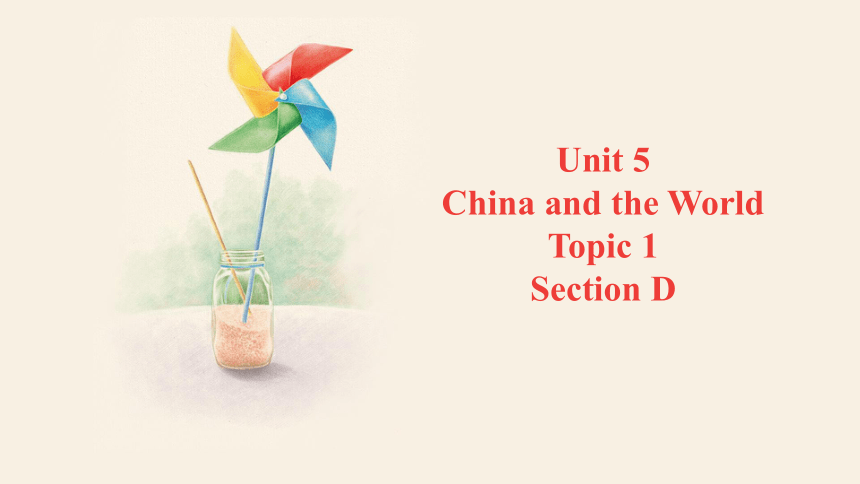 | |
| 格式 | pptx | ||
| 文件大小 | 3.4MB | ||
| 资源类型 | 教案 | ||
| 版本资源 | 仁爱科普版 | ||
| 科目 | 英语 | ||
| 更新时间 | 2024-01-19 14:27:37 | ||
图片预览

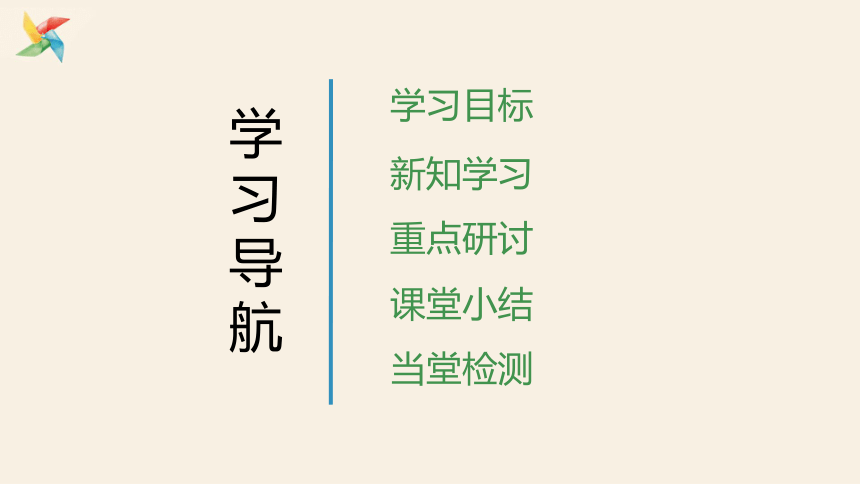
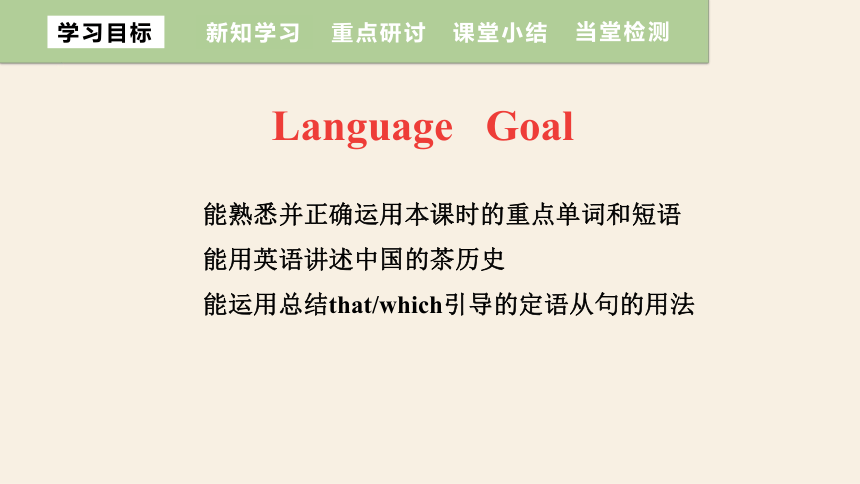
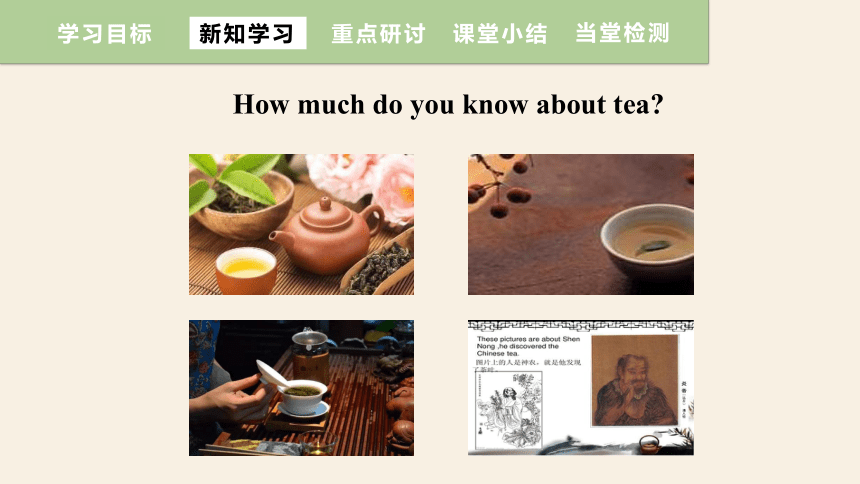
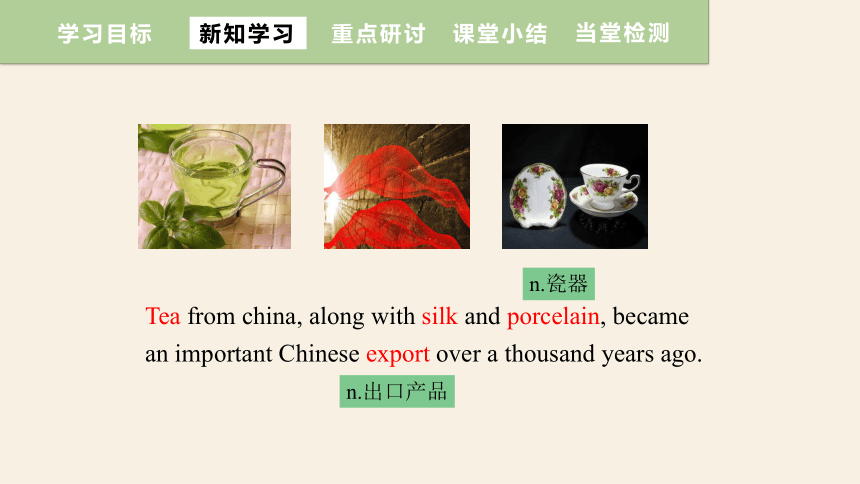
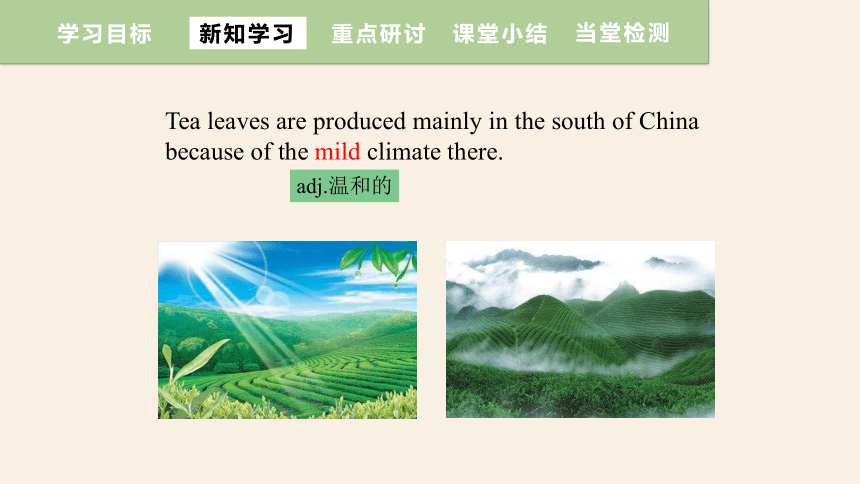
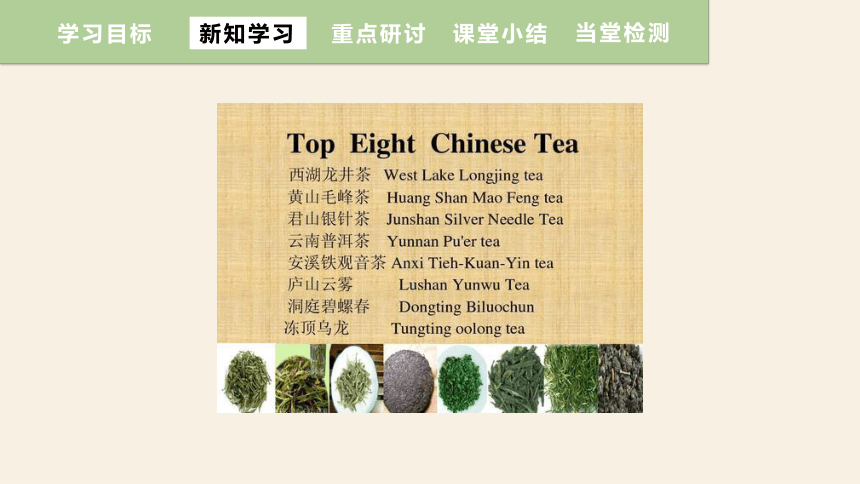
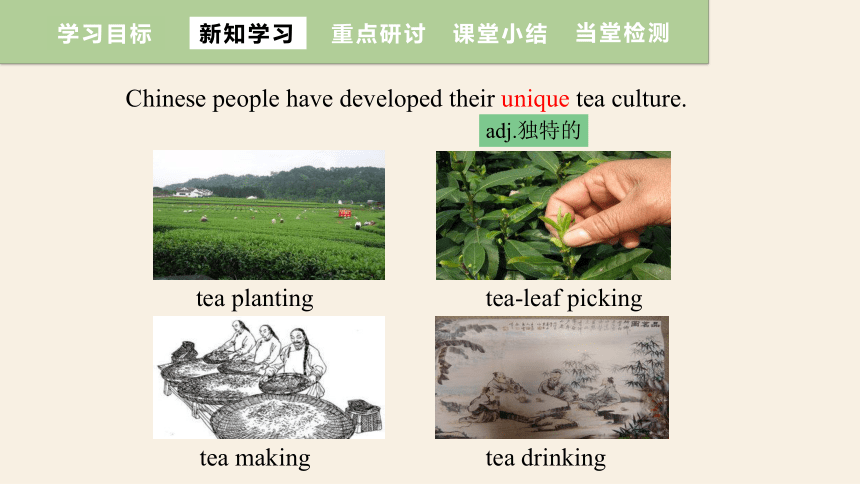
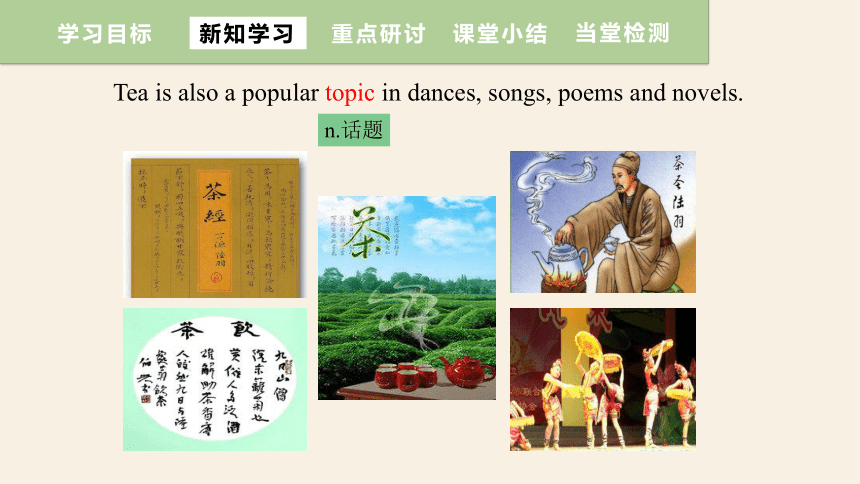
文档简介
(共23张PPT)
Unit 5
China and the World
Topic 1
Section D
学习导航
重点研讨
课堂小结
当堂检测
学习目标
新知学习
新知学习
重点研讨
课堂小结
当堂检测
学习目标
Language Goal
能熟悉并正确运用本课时的重点单词和短语
能用英语讲述中国的茶历史
能运用总结that/which引导的定语从句的用法
新知学习
重点研讨
课堂小结
当堂检测
学习目标
How much do you know about tea
新知学习
重点研讨
课堂小结
当堂检测
学习目标
Tea from china, along with silk and porcelain, became an important Chinese export over a thousand years ago.
n.出口产品
n.瓷器
新知学习
重点研讨
课堂小结
当堂检测
学习目标
Tea leaves are produced mainly in the south of China because of the mild climate there.
adj.温和的
新知学习
重点研讨
课堂小结
当堂检测
学习目标
新知学习
重点研讨
课堂小结
当堂检测
学习目标
Chinese people have developed their unique tea culture.
tea planting
tea-leaf picking
tea making
tea drinking
adj.独特的
新知学习
重点研讨
课堂小结
当堂检测
学习目标
Tea is also a popular topic in dances, songs, poems and novels.
n.话题
新知学习
重点研讨
课堂小结
当堂检测
学习目标
1a Read the following passage and choose the best title for it.
A. China’s Long History of Tea
B. China’s Tea Culture
C. Tea Drinking in China
√
The home of tea, which has more than 4000 years of history, is China. People throughout China drink tea daily. Of the three major drinks — tea, coffee and cocoa, tea is drunk by the largest number of people in the world. Tea from China, along with silk and porcelain, began to be known by the world over a thousand years ago and has been an important Chinese export since then.
The words for “tea” in different languages came from the Chinese character, “cha”. The English word, “tea”, sounds similar to the pronunciation of it in Xiamen, Fujian Province. The Russians call it “cha'i”, which sounds like “chaye” (tea leaves) as it is pronounced in northern China.
新知学习
重点研讨
课堂小结
当堂检测
学习目标
The Japanese character for “tea” is written exactly the same as it is in Chinese, thought it is pronounced a little differently.
Tea leaves are produed mainly in the south of China because of the mild climate and rich soil there. Longjing, Pu'er, Wulong and Tieguanyin are all famous teas. They're produced in the provinces of Zhejiang, Yunnan and Fujian.
Over the past centuries, Chinese people have developed their unique tea culture, including tea planting, tea-leaf picking, tea making and tea drinking. Tea is also a popular topic in dances, songs, poems and novels.
新知学习
重点研讨
课堂小结
当堂检测
学习目标
新知学习
重点研讨
课堂小结
当堂检测
学习目标
1. Chinese tea became world-famous over one thousand years ago.
( )
2. The sound of the English word “tea” is similar to that of “chaye” in
northern China. ( )
3. The written forms of the word “tea” are totally the same in both
Chinese and Japanese. ( )
4. Famous tea leaves in China are produced mainly in the southern part
of the country. ( )
5. Tea drinking is the only part of the Chinese tea culture. ( )
T
F
T
T
F
1b Read 1a again and mark T(True) or F(False).
新知学习
重点研讨
课堂小结
当堂检测
学习目标
2a Work in groups to list some unique Chinese tea culture which you know.
新知学习
重点研讨
课堂小结
当堂检测
学习目标
1. The friendship between gentlemen is like a cup of tea.
君子之交淡如水。
2. Firewood, rice, oil, salt, sauce, vinegar and tea are necessary to
begin a day.
开门七件事:柴、米、油、盐、酱、醋、茶。
2b Translate the following saying about tea into Chinese and discuss your understanding of them with your partner.
1. China is a great country with about 5000 years of history.
→ China is a great counrty (which/that) has about 5 000 years of history.
2. It is a book with details about China.
→ It is a book (which/that) introduces China in detail.
Attributive clauses(II)
新知学习
重点研讨
课堂小结
当堂检测
学习目标
新知学习
重点研讨
课堂小结
当堂检测
学习目标
And some of them are very famous, such as Mount Tai, Mount Huang, Mount Song and Mount Emei.
That's correct!
Founctions
新知学习
重点研讨
课堂小结
当堂检测
学习目标
Project
1. Mark the following places on the map.
a. Mount Tai b. Mount Hua c. Hong Kong
d. Macao e. Taiwan f. the West Lake g. Tibet
2. Choose the place you like best, and collect some pictures
and information to make a booklet about it.
3. Write a description under each picture with attributive
clauses.
4. Display your booklet in class.
Language points
新知学习
重点研讨
课堂小结
当堂检测
学习目标
1. Tea from China, along with silk and porcelain, began to be
known by the world over a thousand years ago and has been
an important Chinese export since then.
和丝绸、瓷器一样,中国的茶叶在一千多年前就被世人所知, 并且从那时起就一直是中国重要的出口产品。
along with 随着;和……一起
当主语与along with连用时,谓语动词与along with前面的
主语在人称和数上保持一致。
e.g. He comes along with some friends.
他和几个朋友一道来的。
2. The Japanese character for “tea” is written exactly the same as it is in Chinese, thought it is pronounced a little differently.
“茶”的日文字和中文字写得一模一样,但发音有点不同。
the same as 与……同样的
different from 与……不同
e.g. Will I get treated the same as everyone else
我会得到与其他人同样的对待吗?
Now it is different from the past.
现在和过去不同了。
新知学习
重点研讨
课堂小结
当堂检测
学习目标
3. Tea leaves are produced mainly in the south of China because of the mild climate and rich soil there.
我国南方气候温和,土壤肥沃,主要生产茶叶。
because of 因为
because of是复合介词,后面加名词或相当于名词的词、代词、动名词、what 从句等
because是连词,引导从句
e.g. She doesn’t go out because of the rain.
She doesn’t go out because it's raining.
因为下雨,她没有出去。
新知学习
重点研讨
课堂小结
当堂检测
学习目标
新知学习
重点研讨
课堂小结
当堂检测
学习目标
用英语讲述中国的茶文化
归纳总结定语从句
Unit 5 Topic 1
Section D
新知学习
重点研讨
课堂小结
当堂检测
学习目标
一、根据句意及汉语提示完成句子。
1. All the students went to the playground __________(包含)
Kangkang and Maria.
2. People ________(认为) Taiwan as “the Treasure Island of
China”.
3. Police tried to _________(使分开) the two men who
were fighting.
4. You can’t _______(期望) to learn a foreign language in a
few months.
5. Hong Kong is ________(著名的) as “the Shopping Heaven”.
including
regard
separate
expect
famous
Unit 5
China and the World
Topic 1
Section D
学习导航
重点研讨
课堂小结
当堂检测
学习目标
新知学习
新知学习
重点研讨
课堂小结
当堂检测
学习目标
Language Goal
能熟悉并正确运用本课时的重点单词和短语
能用英语讲述中国的茶历史
能运用总结that/which引导的定语从句的用法
新知学习
重点研讨
课堂小结
当堂检测
学习目标
How much do you know about tea
新知学习
重点研讨
课堂小结
当堂检测
学习目标
Tea from china, along with silk and porcelain, became an important Chinese export over a thousand years ago.
n.出口产品
n.瓷器
新知学习
重点研讨
课堂小结
当堂检测
学习目标
Tea leaves are produced mainly in the south of China because of the mild climate there.
adj.温和的
新知学习
重点研讨
课堂小结
当堂检测
学习目标
新知学习
重点研讨
课堂小结
当堂检测
学习目标
Chinese people have developed their unique tea culture.
tea planting
tea-leaf picking
tea making
tea drinking
adj.独特的
新知学习
重点研讨
课堂小结
当堂检测
学习目标
Tea is also a popular topic in dances, songs, poems and novels.
n.话题
新知学习
重点研讨
课堂小结
当堂检测
学习目标
1a Read the following passage and choose the best title for it.
A. China’s Long History of Tea
B. China’s Tea Culture
C. Tea Drinking in China
√
The home of tea, which has more than 4000 years of history, is China. People throughout China drink tea daily. Of the three major drinks — tea, coffee and cocoa, tea is drunk by the largest number of people in the world. Tea from China, along with silk and porcelain, began to be known by the world over a thousand years ago and has been an important Chinese export since then.
The words for “tea” in different languages came from the Chinese character, “cha”. The English word, “tea”, sounds similar to the pronunciation of it in Xiamen, Fujian Province. The Russians call it “cha'i”, which sounds like “chaye” (tea leaves) as it is pronounced in northern China.
新知学习
重点研讨
课堂小结
当堂检测
学习目标
The Japanese character for “tea” is written exactly the same as it is in Chinese, thought it is pronounced a little differently.
Tea leaves are produed mainly in the south of China because of the mild climate and rich soil there. Longjing, Pu'er, Wulong and Tieguanyin are all famous teas. They're produced in the provinces of Zhejiang, Yunnan and Fujian.
Over the past centuries, Chinese people have developed their unique tea culture, including tea planting, tea-leaf picking, tea making and tea drinking. Tea is also a popular topic in dances, songs, poems and novels.
新知学习
重点研讨
课堂小结
当堂检测
学习目标
新知学习
重点研讨
课堂小结
当堂检测
学习目标
1. Chinese tea became world-famous over one thousand years ago.
( )
2. The sound of the English word “tea” is similar to that of “chaye” in
northern China. ( )
3. The written forms of the word “tea” are totally the same in both
Chinese and Japanese. ( )
4. Famous tea leaves in China are produced mainly in the southern part
of the country. ( )
5. Tea drinking is the only part of the Chinese tea culture. ( )
T
F
T
T
F
1b Read 1a again and mark T(True) or F(False).
新知学习
重点研讨
课堂小结
当堂检测
学习目标
2a Work in groups to list some unique Chinese tea culture which you know.
新知学习
重点研讨
课堂小结
当堂检测
学习目标
1. The friendship between gentlemen is like a cup of tea.
君子之交淡如水。
2. Firewood, rice, oil, salt, sauce, vinegar and tea are necessary to
begin a day.
开门七件事:柴、米、油、盐、酱、醋、茶。
2b Translate the following saying about tea into Chinese and discuss your understanding of them with your partner.
1. China is a great country with about 5000 years of history.
→ China is a great counrty (which/that) has about 5 000 years of history.
2. It is a book with details about China.
→ It is a book (which/that) introduces China in detail.
Attributive clauses(II)
新知学习
重点研讨
课堂小结
当堂检测
学习目标
新知学习
重点研讨
课堂小结
当堂检测
学习目标
And some of them are very famous, such as Mount Tai, Mount Huang, Mount Song and Mount Emei.
That's correct!
Founctions
新知学习
重点研讨
课堂小结
当堂检测
学习目标
Project
1. Mark the following places on the map.
a. Mount Tai b. Mount Hua c. Hong Kong
d. Macao e. Taiwan f. the West Lake g. Tibet
2. Choose the place you like best, and collect some pictures
and information to make a booklet about it.
3. Write a description under each picture with attributive
clauses.
4. Display your booklet in class.
Language points
新知学习
重点研讨
课堂小结
当堂检测
学习目标
1. Tea from China, along with silk and porcelain, began to be
known by the world over a thousand years ago and has been
an important Chinese export since then.
和丝绸、瓷器一样,中国的茶叶在一千多年前就被世人所知, 并且从那时起就一直是中国重要的出口产品。
along with 随着;和……一起
当主语与along with连用时,谓语动词与along with前面的
主语在人称和数上保持一致。
e.g. He comes along with some friends.
他和几个朋友一道来的。
2. The Japanese character for “tea” is written exactly the same as it is in Chinese, thought it is pronounced a little differently.
“茶”的日文字和中文字写得一模一样,但发音有点不同。
the same as 与……同样的
different from 与……不同
e.g. Will I get treated the same as everyone else
我会得到与其他人同样的对待吗?
Now it is different from the past.
现在和过去不同了。
新知学习
重点研讨
课堂小结
当堂检测
学习目标
3. Tea leaves are produced mainly in the south of China because of the mild climate and rich soil there.
我国南方气候温和,土壤肥沃,主要生产茶叶。
because of 因为
because of是复合介词,后面加名词或相当于名词的词、代词、动名词、what 从句等
because是连词,引导从句
e.g. She doesn’t go out because of the rain.
She doesn’t go out because it's raining.
因为下雨,她没有出去。
新知学习
重点研讨
课堂小结
当堂检测
学习目标
新知学习
重点研讨
课堂小结
当堂检测
学习目标
用英语讲述中国的茶文化
归纳总结定语从句
Unit 5 Topic 1
Section D
新知学习
重点研讨
课堂小结
当堂检测
学习目标
一、根据句意及汉语提示完成句子。
1. All the students went to the playground __________(包含)
Kangkang and Maria.
2. People ________(认为) Taiwan as “the Treasure Island of
China”.
3. Police tried to _________(使分开) the two men who
were fighting.
4. You can’t _______(期望) to learn a foreign language in a
few months.
5. Hong Kong is ________(著名的) as “the Shopping Heaven”.
including
regard
separate
expect
famous
同课章节目录
- Unit 5 China and the world
- Topic 1 China attracts millions of tourists from a
- Topic 2 He is really the pride of China.
- Topic 3 Now it is a symbol of England.
- Unit 6 Entertainment and Friendship.
- Topic 1 I would rather watch sports shows than tho
- Topic 2 Who is your favorite character in literatu
- Topic 3 I will remember our friendship forever.
